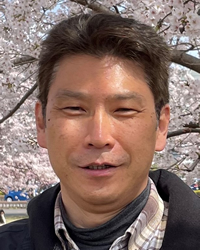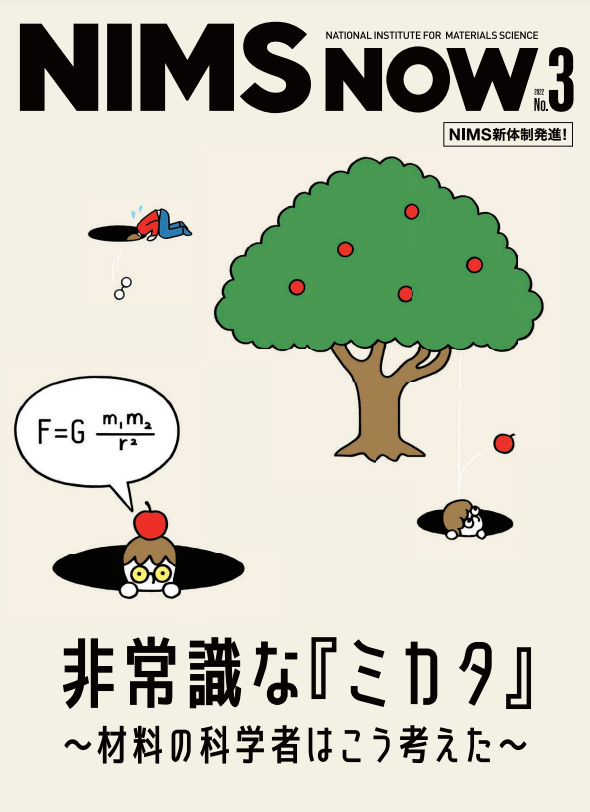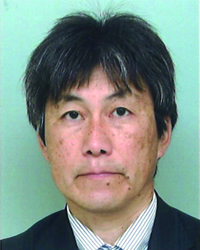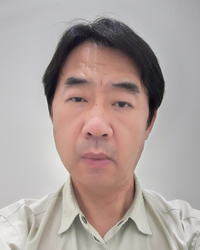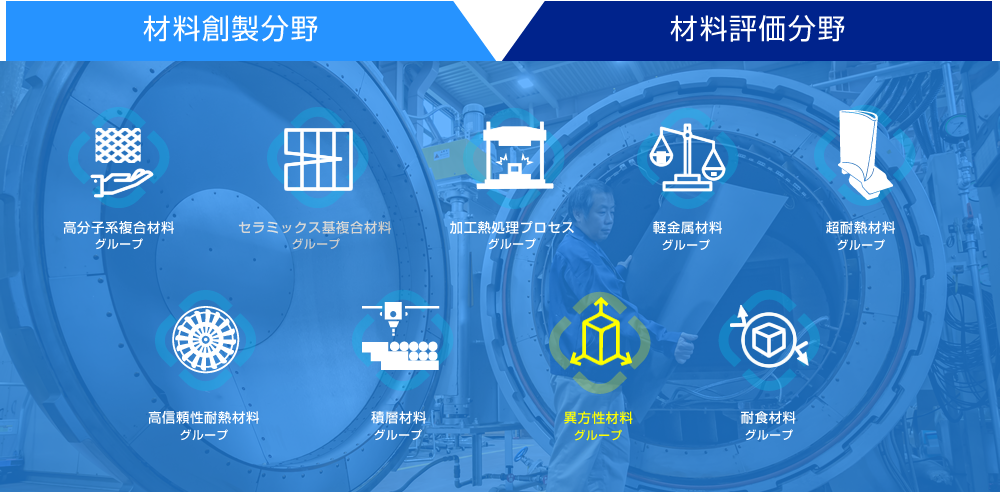 ↑他グループへはアイコンをクリック
↑他グループへはアイコンをクリック
異方性材料グループ
Anisotropic Materials Group
新たな材料の創出に向け、異方性・複層化・複合化を積極的に活用した材料の研究に取り組みます。具体的には、従来の等方・均質な材料の限界を打破する特性 (強靭化、耐水素脆化など) を目指す中で、生物などの組織・構造を理解し、異方性材料の分析・評価を実施し、結果を材料創製プロセスにフィードバックする研究スタイルで取り組みます。
メンバー
井上 忠信 INOUE Tadanobu
構造材料研究センター 材料創製分野
異方性材料グループ グループリーダー
木村 勇次 KIMURA Yuuji
構造材料研究センター 材料創製分野
異方性材料グループ 主席研究員
低合金鋼,加工熱処理,強度,靭性,水素脆化![]()
邱 海 QIU Hai
構造材料研究センター 材料創製分野
異方性材料グループ 主幹研究員
Structural steel, fracture mechanics, strain, microstructure
専門分野・研究対象
構造材料の強靭化
構造用金属材料は高強度によって脆化するため、強靭な材料を実現するためのアイデアが常に求められています。社会で利用される構造用金属材料の多くは、強度というよりはむしろ靭性で決定されています。よって、我々は靭性と組織の関係を詳細に検討します。特に、従来の均質・等方な材料の設計思想に捉われず、生物の持つ複雑な組織構造を参考 (バイオミメティクス) にすることで、材料の強靭特性向上を目指します。
Tadanobu Inoue, Yuuji Kimura. Effect of Delamination and Grain Refinement on Fracture Energy of Ultrafine-Grained Steel Determined Using an Instrumented Charpy Impact Test. Materials. 15 [3] (2022) 867 10.3390/ma15030867
Tadanobu Inoue, Rintaro Ueji. Improvement of strength, toughness and ductility in ultrafine-grained low-carbon steel processed by warm bi-axial rolling. Materials Science and Engineering: A. 786 (2020) 139415 10.1016/j.msea.2020.139415
井上 忠信, 上路 林太郎, 木村 勇次. 炭素鋼の強靭延性化の方向性. 日本機械学会論文集. 84 [866] (2018) 18-00237 10.1299/transjsme.18-00237
生物から学ぶ
生物の複雑な階層構造を模倣しようとする研究は、材料の特性限界を突破するための技術としてしばしば行われます。「バイオミメティクス」研究は、これらの材料が持つ特異な機械的および機能的特性と複雑な階層構造により、ますます関心を集めています。多くの動物は、体重の数倍の力を持っていますが、体重1kgほどの生物では、甲殻類の挟む力は他の生物の力を大きく上回ります。よって、甲殻類のハサミの外骨格は、強靭である必要があり、通常の金属組織にはない螺旋合板構造のような複雑な組織を持ちます。このような組織や構造を理解することで、従来の金属材料にはない特性を有した材料の開発に繋げます。
Tadanobu Inoue, Yuka Hara, Koji Nakazato. Mechanical Resistance of the Largest Denticle on the Movable Claw of the Mud Crab. Biomimetics. 8 [8] (2023) 602 10.3390/biomimetics8080602
Tadanobu Inoue, Takanobu Hiroto, Yuka Hara, Koji Nakazato, Shin-ichiro Oka. Tissue structure and mechanical properties of the exoskeleton of the huge claws of the mud crab, Scylla serrata. Journal of Materials Science. 58 [3] (2023) 1099-1115 10.1007/s10853-022-08083-x
Tadanobu Inoue, Shin-ichiro Oka, Toru Hara. Three-dimensional microstructure of robust claw of coconut crab, one of the largest terrestrial crustaceans. Materials & Design. 206 (2021) 109765 10.1016/j.matdes.2021.109765
超高強度鋼の開発
超微細繊維状結晶粒組織を有するフェールセーフ鋼は、階層的な異方性組織によって従来鋼よりも格段に優れた強靭性を示します。本研究では、これまでに明らかにしてきたフェールセーフ鋼の組織制御技術を基盤として、異方性を活用した超高強度鋼の更なる進化を目指します。超高強度鋼の社会実装にボルトネックとなっている遅れ破壊に着目して、異方性組織を有する超高強度鋼の遅れ破壊の発生機構を解明するとともに耐遅れ破壊特性に優れた超高強度鋼の開発に取り組みます。
Yuuji Kimura, Taku Moronaga, Tadanobu Inoue. Influence of Thermomechanical Treatment on Delayed Fracture Property of Mo-Bearing Medium-Carbon Steel. ISIJ International. 62 [2] (2022) ISIJINT-2021-407 10.2355/isijinternational.isijint-2021-407
Yuuji Kimura, Tadanobu Inoue. Influence of Annealing on Delamination Toughening of Mo-Bearing Medium-Carbon Steel with Ultrafine Elongated Grain Structure Processed by Warm Tempforming. ISIJ International. 62 [2] (2022) ISIJINT-2021-068 10.2355/isijinternational.isijint-2021-068
Yuuji Kimura, Tadanobu Inoue, Toshio Otani, Akihiro Ochiai, Shohei Ikurumi, Tomohiro Takatsuji. Upsizing High-Strength Fail-Safe Steel through Warm Tempforming. Materials Science and Engineering: A. 819 (2021) 141514 10.1016/j.msea.2021.141514
Yuuji Kimura, Tadanobu Inoue. Mechanical Property of Ultrafine Elongated Grain Structure Steel Processed by Warm Tempforming and Its Application to Ultra-High-Strength Bolt. ISIJ International. 60 [6] (2020) 1108-1126 10.2355/isijinternational.isijint-2019-726
異方性特性および発生機構の解明
等方性材料の微視組織と特性の関係に比べ、異方性材料のそれらの関係は不明な点が多い。異方性材料 (生物の外骨格、超微細繊維状結晶粒組織鋼など) を対象に、強度特性と靭性特性をマクロ試験とミクロ試験で計測し、異方特性を明らかにします。当グループ開発したその場観察・計測システムを用い、局所変形の過程を解析し、異方性の発生機構と微視組織の関係を解明することを目指します。
Hai Qiu, Rintaro Ueji, Tadanobu Inoue. Yield-Point Phenomenon and Plastic Bands in Ferrite–Pearlite Steels. Materials. 16 [1] (2023) 195 10.3390/ma16010195
Hai Qiu, Tadanobu Inoue. Evolution of Poisson’s Ratio in the Tension Process of Low-Carbon Hot-Rolled Steel with Discontinuous Yielding. Metals. 13 [3] (2023) 562 10.3390/met13030562
Hai Qiu, Rintaro Ueji, Yuuji Kimura, Tadanobu Inoue. Grain-to-Grain Interaction Effect in Polycrystalline Plain Low-Carbon Steel within Elastic Deformation Region. Materials. 14 [8] (2021) 1865 10.3390/ma14081865
Hai Qiu, Rintaro Ueji, Yuuji Kimura, Tadanobu Inoue. Heterogeneous Distribution of Microstrain Evolved During Tensile Deformation of Polycrystalline Plain Low Carbon Steel. Metals. 10 [6] (2020) 774 10.3390/met10060774
